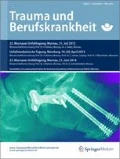Zusammenfassung
Bei veralteten Schultereckgelenkverletzungen spielt das Ausmaß der Schädigung der korakoklavikularen Bänder, der Akromioklavikulargelenkkapsel mit ihren Verstärkungsbändern sowie insbesondere auch der für die horizontale Stabilität wichtigen Deltotrapezoidfaszie eine große Rolle. Bisher gibt es für veraltete Schultereckgelenkverletzungen keine Klassifikation. Um Kriterien für die Therapieentscheidung zu erarbeiten, wurden prospektiv klinische, radiologische und sonographische Daten zu veralteten Eckgelenkverletzungen standardisiert erhoben, ausgewertet und eine Einteilung in 3 Typen, A, B und C, mit den 4 Untertypen B1, B2, C1 und C2, definiert. Die veralteten Verletzungen des Typs A scheinen für die Behandlung nach der einfachen Weaver-Dunn-Methode geeignet, in allen anderen Fällen ist eine zusätzliche temporäre Retention des Akromioklavikulargelenks in Kombination mit einer Rekonstruktion der Deltotrapezoidfaszie und ggf. bandplastischen Maßnahmen erforderlich.
Abstract
In old injuries of the acromioclavicular (AC) joint the extent of damage to the coracoclavicular ligaments, the AC joint capsule with its strengthening ligaments and in particular the deltotrapezius fascia which is responsible for horizontal stability play an important role. Previously there was no classification of old AC joint injuries. In order to work out criteria for therapy decisions prospective clinical, radiological and sonographic data on old AC injuries were compiled in a standardized way, evaluated and divided into three types A, B and C with four defined subtypes B1, B2, C1 and C2. Old injuries of type A seem to be suitable for treatment by the Weaver-Dunn method but for all other types an additional temporary retention of the AC joint in combination with reconstruction of the deltotrapezius fascia and sometimes ligamentoplastic measures are necessary.




Literatur
Alexander OM (1949) Dislocation of the acromio-clavicular joint. Radiography 15:260
Allman FL Jr (1967) Fractures and ligamentous injuries of the clavicle and its articulation. J Bone Joint Surg Am 49-A:774–784
Bundens WD, Cook JI (1961) Repair of acromioclavicular separations by deltoid-trapezius imbrication. Clin Orthop Relat Res 20:109–115
Constant CR, Murley AH (1987) A clinical method of functional assessment of the shoulder. Clin Orthop Relat Res 214:160–164
Fukuda K, Craig EV, An K, Cofield RH, Chao EYS (1986) Biomechanical study of the ligamentous system of the acromioclavicular joint. J Bone Joint Surg Am 68-A:434–440
Guy DK, Wirth MA, Griffen JL, Rockwood CA Jr (1998) Reconstruction of chronic and complete dislocations of the acromioclavicular joint. Clin Orthop Relat Res 347:138–149
Heers G, Hedtmann A (2005) Correlation of ultrasonographic findings to Tossy’s and Rockwood’s classification of acromioclavicular joint injuries. Ultrasound Med Biol 31:725–732
Hedtmann A, Fett H, Ludwig J (1998) Die Behandlung veralteter, posttraumatischer Akromioklavikulargelenkinstabilitäten und -arthrosen. Orthopäde 8:556–566
Horn JA (1954) The traumatic anatomy and treatment of acute acromio-clavicular dislocation. J Bone Joint Surg Br 36-B:194–201
Kumar S, Penematsa SR, Selvan T (2007) Surgical reconstruction for chronic painful acromioclavicular joint dislocations. Arch Orthop Trauma Surg 127:481–484
Phillips AM, Smart C, Groom AFG (1998) Acromioclavicular dislocation. Conservative or surgical therapy. Clin Orthop Relat Res 353:10–17
Powers JA, Bach PJ (1974) Acromioclavicular separation. Closed or open treatment? Clin Orthop Relat Res 104:213–223
Rockwood CA Jr (1984) Injuries to the acromioclavicular joint. In: Roockwood CA, Green DP (Hrsg) Fractures in adults, Bd 1, 2. Aufl. Lippincott, Philadelphia, S 860–910
Rockwood LA, Williams GR, Young DC (1988) Disorders of the acromioclavicular joint. In: Rockwood CA, Matsen F von (Hrsg) The shoulder, 2nd edn. Saunders, Philadelphia, S 483–553
Rolf O, Hann von Weyhern A, Ewers A, Böhm TD, Gohlke F (2008) Acromioclavicular dislocation Rockwood III–V: results of early versus delayed surgical treatment. Arch Orthop Trauma Surg 128:1153–1157
Rowe CR (1988) Acromioclavicular and sternoclavicular joints. In: Rowe CR (Hrsg) The shoulder. Churchill Livingstone, New York, S 2393–328
Sondergard-Petersen P, Mikkelsen P (1982) Posterior acromioclavicular dislocation. J Bone Joint Surg Br 64-B:52–53
Sood A, Wallwork N, Bain GI (2008) Clinical results of coracoacromial ligament transfer in acromioclavicular dislocations. A review of published literature. Int J Shoulder Surg 2:13–21
Tauber M, Gordon K, Koller H, Fox M, Resch H (2009) Semitendinosus tendon graft versus a modified Weaver-Dunn procedure for acromioclavicular joint reconstruction in chronic cases: a prospective comparative study. Am J Sports Med 37:181–190
Tossy JD, Mead NC, Sigmond HM (1963) Acromioclavicular separations: useful and practical classification for treatment. Clin Orthop Relat Res 28:111–119
Urist MR (1946) Complete dislocation of the acromioclavicular joint: the nature of the traumatic lesions and effective methods of treatment with an analysis of forty-one cases. J Bone Joint Surg Am 28-A:813–837
Weaver JK, Dunn HK (1972) Treatment of acromioclavicular injuries, especially complete acromioclavicular separations. J Bone Joint Surg Am 54-A:1187–1197
Zanca P (1971) Shoulder pain: involvement of the acromioclavicular joint. Analysis of 1000 cases. AJR Am J Roentgenol 112:493–506
Interessenkonflikt
Der korrespondierende Autor gibt an, dass kein Interessenkonflikt besteht.
Author information
Authors and Affiliations
Corresponding author
Rights and permissions
About this article
Cite this article
Hedtmann, A., Heers, G. Alte Akromioklavikulargelenkverletzungen. Trauma Berufskrankh 14 (Suppl 1), 12–17 (2012). https://doi.org/10.1007/s10039-011-1819-8
Published:
Issue Date:
DOI: https://doi.org/10.1007/s10039-011-1819-8

